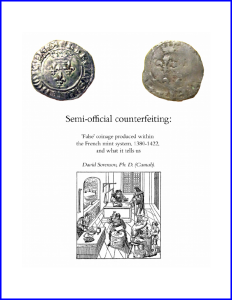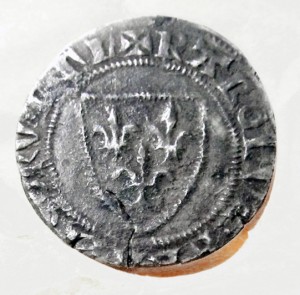 David W. Sorenson
David W. Sorenson
(David Berman, Numismatist)
“Semi-Official Counterfeiting: ‘False’ Coinage Produced within the
French Mints, 1380–1422, and What It Tells Us”
Abstract of Paper Presented at the
50th International Congress on Medieval Studies (Kalamazoo, 2015)
Session on “Making It or Faking It?
The Strange Truths of ‘False Witnesses’ to Medieval Forms”
Sponsored by the Research Group on Manuscript Evidence
Organized by Mildred Budny and Sarah M. Anderson
2015 Congress Events Announced and 2015 Congress Events Accomplished
[Published on 20 March 2015, with updates, and now with the publication of the Paper itself]
The study of coinage has uncovered numerous examples of counterfeiting, ranging from “official” counterfeits, where an official mint strikes issues which copy its own issues (extending from the issuance of plated coins with official dies to the production of seriously debased “official” issues) all the way down to run-of-the-mill fakes. This paper looks at a variety of counterfeits, official, semi-official, and private-enterprise in the France of Charles VI (1380–1422), with emphasis on an incident in which mint personnel were caught attempting to produce their own bogus coin.
In “official” cases the mint imitated its own coinage, through producing coinage of lower standards to the same design. In semi-official cases some other mint-produced imitations, either with (e. g. Burgundy) or without (e. g. Rummen) the sanction of the original authority. Slightly less official was the tendency of mint officials to produce substandard coinage when they could get away with it, which resulted in the introduction of mint-marks. Finally, we have all sorts of individuals trying to make some extra cash by faking the coinage, or by creating extras just to have some money for expenses when the official currency did not suffice.
Somewhere on this spectrum falls the case of the Paris mint workers of 1421 who attempted to produce some extra currency of their own. They were caught, hence the information we have about them and their activities. We do not know precisely what happened to them, but the penalties were not light.
*****
The Abstracts for the other presentations by David W. Sorenson at Sessions sponsored by the Research Group on Manuscript Evidence at the International Congress on Medieval Studies appear here:
- Sorenson (2011 Congress)
- Sorenson (2012 Congress)
- Sorenson (2013 Congress)
- Sorenson (2014 Congress)
- Sorenson (2015 Congress)
- Sorenson (2016 Congress)
The first four presentations belonged to our annual series of sessions on “Medieval Writing Materials” at the
See also the 2015 Congress Report. The series resumed for the 2016 Congress.
David’s Abstract for our 2013 Symposium at Princeton University is available here: Identity & Authenticity.
We thank him for his generous contributions to our activities.
*****
Now we publish the illustrated text of this paper on “Semi-Official Counterfeiting” as a freely downloadable pdf. The article is set by David Sorenson in RGME Bembino, also freely available. This publication marks the first of Research Group publications on our website of the full text of a paper presented at our sponsored Congress Sessions.
*****

